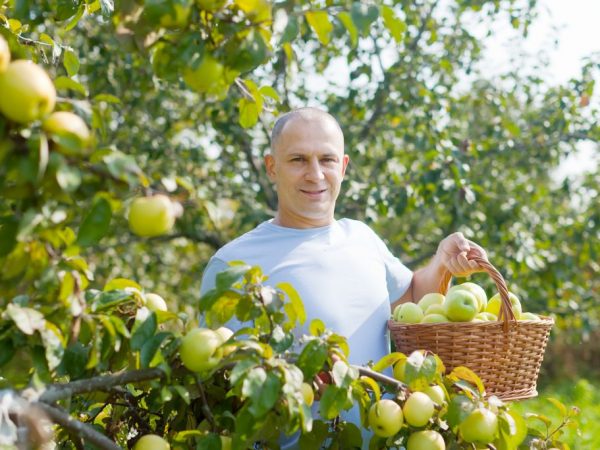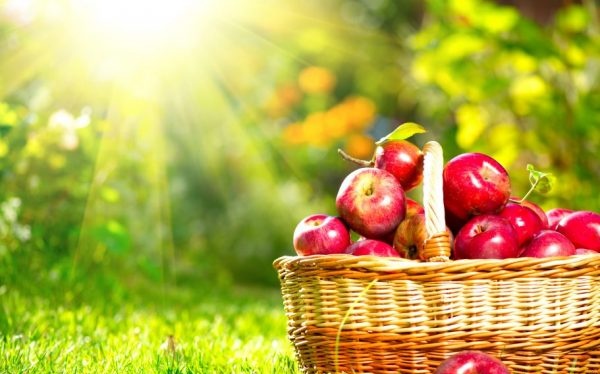How to pick apples correctly
The final stage of growing vegetables and fruit crops is harvesting. Novice gardeners are often interested in how to pick apples from tall plants so as not to damage the branches, and to increase the shelf life of the fruit.

Apple picking rules
The autumn harvest of apples, as a rule, is used for consumption in the cold season, so they must be kept. It is very important to determine the timing of collection: unripe specimens do not have time to accumulate the required amount of trace elements, and overripe ones are unsuitable for long-term storage, they immediately begin to deteriorate.
- First, all previously fallen fruits are collected from the ground around the apple tree. This relieves the site of sick, wormy and poor-quality fruits, which act as sources of the spread of infections.
- You need to pick the crop from the lower branches, gradually moving to those located above.
- For longer storage, the apples are removed together with the stalk.
- Summer varieties of fruits that will be used to make jam, preserves and juices should be torn off in a state of technical maturity, slightly unripe. Winter varieties are harvested as late as possible, but before the first frost.
- Immediately upon plucking, the gardener must carry out the primary sorting of fruits, rejecting all deformed and wormy specimens in a separate bucket.
- Store autumn fruits at a stable cool temperature in ventilated containers.
Use of ready-made pickers
It will not be difficult to harvest from undersized and dwarf apple trees. However, fruit trees are also tall, with impressive sizes, and the highest quality fruits are placed on their tops.
In order not to damage the branches and not cause harm to the tree, gardeners have invented special devices - fruit pickers, which greatly facilitate the collection process.
They can be purchased ready-made in gardening stores or made by yourself. Combines are used for this on an industrial scale.
The fruit picker must meet the following requirements:
- hold fruit firmly;
- be of sufficient height;
- when collecting, do not injure the fruit;
- be convenient in the process of use.
Plastic tulip
The material from which the collector is made is high-strength plastic. The design consists of 2 parts:
- glasses with rounded petals;
- long handle.
The procedure for picking apples with a “tulip” is as follows: the fruit falls into the glass, and its stalk is at this time placed between the petals of the container. To pick the fruit, it is enough to turn the picker in any direction.
Collet fruit pickers (wire)
The puller structure is made of wire, plastic pipe and fishing line.The first is fixed at the end of the telescopic handle, its edges are bent into rings through which the fishing line is threaded, with its help the mechanism is activated.
The apple, after falling into the center of the fruit collector, is fixed by pulling the ends of the fishing line. To separate the fruit from the branch, the gardener must twist the device.
Fruit picker with grab
This type of device is suitable for picking apples of small fruits. They are gripped by special parts made of plastic that look like a three-fingered hand.
The telescopic handle is equipped with a lever, when pressed, the mechanism is activated, and the apple is in the cavity of the fruit collector. After that, all that remains is to pick the fruit from the branch.
The green mass of the tree is often damaged when using the grabbing method.
Sack-shaped fruit collectors
This device is advantageous in that it can be used to remove several fruits in a row at once.
According to the description, a small bag is attached to a round shape with sharp, tin-like petals that act as a knife.
After cutting, the fruit enters the collector without being damaged. The holder is also fixed to the glass, should be comfortable and have sufficient length.
Homemade fruit pickers

Apples, correctly harvested, keep well
It is not necessary to purchase a ready-made device for harvesting, the device can be easily made independently, with your own hands, from scrap materials.
This is a budget option; it does not require a gardener to have special skills or knowledge. It is enough to familiarize yourself with the design diagram and stock up on the necessary tools.
Fruit picker from a plastic bottle
A simple and affordable homemade mechanism that even a beginner can create. To do this, you will need the following tools and materials:
- plastic container with a volume of 2-2.5 liters;
- a long stick will act as a holder;
- wire or strong scourge.
Step-by-step instruction
- The bottle is cut into 2 parts. The part with the neck will be used.
- A wedge-shaped slit is made on the cut line, which will help separate the fruit stem from the branch.
- A stick of the required length is securely attached to the neck using a whip or wire.
Fruit picker made of plastic pipe
This apple picker is similar to a collet design and operates in the same way. For manufacturing you will need:
- plastic bottle with a capacity of 2.5 liters;
- fishing line;
- long hollow pole (pipe).
Step-by-step instruction
- The holder is attached to the neck with the help of available materials.
- A round hole is cut in the middle, which is larger than the diameter of the fruit.
- In a circle, with a sharp part towards the neck, I make a tapered incision.
- The bottom of the bottle is cut off, and peculiar petals are formed on the same side along the edges, in each it is necessary to make 2 holes.
- The end of the line is threaded through the neck, then lead through each hole and brought out again through the neck.
- By the last days, a hollow stick or pipe is firmly attached, through which 2 ends are pulled.
- Having placed the fruit in the cavity of the container, the gardener must pull on the edges of the fishing line, while the petals close together, and will not allow the fruit to fall out of a kind of purse. To separate the apple from the branch, you need to turn the handle of the device in any direction.
Fruit picker from a tin can
Even an old tin can can come in handy on the farm and surprise with its useful qualities. For the manufacture of a fruit picker you will need:
- old tin can with a capacity of 1 liter;
- garden hairpins rectangular;
- thick fishing line or strong cord;
- hollow holder of the required length;
- bag or mesh.
Step-by-step instruction
- The jar is cut in the form of a closed ring.
- On the one hand, pins in the shape of a cage are fixed on it, their upper edges are bent in the form of rings, a fishing line is pulled through them.
- The ends are pulled through the holder to its handle.
- On the other side of the ring, a cloth bag is fixed, into which the fruits will penetrate.
- After the apple hits the cage, the line is pulled together, and the stripper with a grip is gently pulled down or sideways. The fruit with the stalk falls into the bag without being damaged.
Determination of the ripeness of apples
The timing of fruit picking in the country depends on the type of crop, temperature and humidity in certain regions, the quality of plant care, and begins in October - November.
Determine the degree of maturity of apples in several ways.
- Abundant carrion. If the gardener observes a massive fall, among which there are many large fruits, the fruits can be harvested;
- With slight pressure with a finger on the surface, the dent disappears immediately - the apples are not yet ripe; if the skin has burst and parted - overripe; the recess retains its shape - indicates the need to start collecting.
- Appearance. Ripe autumn fruit has an even color, without blotches or darkening. The pulp is creamy, pleasant to the taste. Seeds in the stage of maturity acquire a uniform brown color.
- Chemical method. To carry it out, it is necessary to prepare a solution of water, iodine and potassium iodide. A drop of liquid is placed on the apple cut. In unripe fruits, there is a large amount of starch, which immediately reacts with the solution, and the surface of the fruit turns blue. A rich yellow color indicates that the crop is overripe. Ideally, the drop has a yellow center, with a blue border around the edges.
Picking apples is a laborious process that does not require haste and negligence. Depending on how correctly and competently it was carried out, the duration of storage of the fruit and the general condition of the fruit tree after harvesting will depend.


